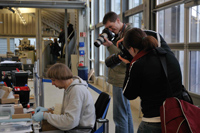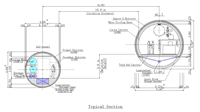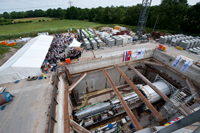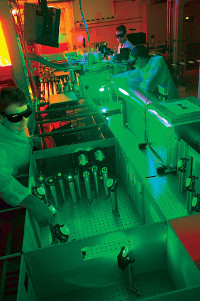 |
|
|
 |
From interactions.org: World's particle physics labs take amateur photographers behind the scenes

A scene from the first photo walk at DESY in 2009 Image: Christian Mrotzek |
8 July 2010 – Picture this: For the first time, amateur photographers around the world collide with the past, present and future of particle physics.
Five of the world's leading particle physics laboratories will make the image a reality when they join together to host a Particle Physics Photowalk on August 7. More than 200 people will have the rare opportunity to photograph state-of-the-art accelerators and detectors in all their beauty and complexity. Photographers will benefit from special behind-the-scenes access to laboratories in Asia, Europe and North America, with tours tailored to the creative eye.
Photographers are invited to register for a Particle Physics Photowalk at these participating laboratories:
- CERN in Geneva, Switzerland
- DESY in Hamburg, Germany
- Fermilab in Illinois, USA
- KEK in Tsukuba, Japan
- TRIUMF in Vancouver, Canada
Read more or visit website
|
 |
|
|
 |
| Upcoming meetings, conferences, workshops
7th Positron Source Collaboration Meeting
DESY, Hamburg, Germany
15-16 July 2010
TeV Particle Astrophysics 2010
Paris, France
19-23 July 2010
35th International Conference on High Energy Physics (ICHEP2010)
Palais des Congrès, Paris, France
21-28 July 2010
First Baseline Assessment Workshop
KEK, Tsukuba, Japan
7-10 September 2010
XXV Linear Accelerator Conference (LINAC10)
Tsukuba, Japan
12-17 September 2010
Upcoming school
Fifth CERN-Fermilab Hadron Collider Physics Summer School
Fermilab, Batavia, IL, USA
16-27 August 2010
|
|
|
GDE Meetings calendar
View complete ILC calendar
|
|
|
 |
One step forward to the ILC single tunnel design

Asian single tunnel configuration Image: AAA CE-WG |
On 1-2 June, the review on the design study of the ILC conventional facility in mountain regions was held at KEK, Japan, and the final review report was submitted last week by the review panel lead by Vic Kuchler of Fermilab to Seiya Yamaguchi, head of KEK's Linear Collider Office and to Marc Ross, project manager of the Global Design Effort (GDE) in charge of the conventional facility study (GDE/CFS).
Read more...
-- Rika Takahashi |
 |
|
|
 |
Exciting boring ceremony

In an official ceremony filled with German civil engineering traditions the tunnel boring works for the European XFEL started on 30 June. The boring machine – with its 6.17 metres in diameter, 71 metres in length, weighing 550 tonnes and costing 18 million Euros everything but boring – was christened (it is now called 'TULA'), the tunnel itself was also christened and a statue of the saint in charge of tunnel works was blessed. The statue will watch over the construction work until the tunnel borer finishes its three-kilometer tunneling job in summer 2011. The European XFEL is an X-ray free-electron laser that will use superconducting radiofrequency technology to produce its brilliant X-ray light. Read the press release.
|
 |
|
|
 |
From Physics World
1 July 2010
Ultra-precise test confirms photons are bosons
Physicists in the US have carried out an extremely precise test of the one of the cornerstones of modern physics – the idea that the two types of fundamental particle, bosons and fermions, follow two distinct kinds of statistical behaviour.
Read more... |
|
From Wired
1 July 2010
New Muon Detector Could Find Hidden Nukes
A prototype of a device that could someday detect nukes through layers of steel just passed its first test.
Read more... |
|
From livemint.com
30 June 2010
Will it lead to confusion or champagne?
Expectations vary as particle physics is dominated as much by subatomic structures as by personal perspectives
Read more... |
|
From About.com: Physics
30 June 2010
Introducing Dark Watch
... Welcome to Dark Watch, my monthly update on all things dark matter-ish and dark energy-ish.
Read more... |
|
From Ars Technica
29 June 2010
A short history of the history of the Universe
John Mather, along with George Smoot, won the Nobel Prize for his work on the Cosmic Background Explorer (COBE), the probe that first caught glimpses of fluctuations in the Cosmic Microwave Background (CMB) left over from the big bang.
Read more... |
|
|
 |
 |
|
|
 |
The laser and the next 50 years

The laser used to accelerate electrons by plasma-wakefield acceleration to one billion electron volts in only three centimetres. (From Symmetry Magazine October 2009 – Image: Roy Kaltschmidt, Lawrence Berkeley National Laboratory) |
In my column last week on the 50th anniversary of the demonstration of the first working laser at Hughes Research Laboratory in 1960, I stressed the remarkable impacts this fundamental physics discovery has had both in developing a multibillion-dollar industry and in affecting the way we live. Today, I continue that theme by projecting a little on what we can expect from further laser developments in the next fifty years. Of course, undoubtedly, some of the most important future developments have not even been thought of yet. Nevertheless, it is clear that the new laser developments will continue to have an impact on our lives in new and exciting ways, both by opening up new scientific opportunities and in creating new applications to our everyday lives.
Read more...
-- Barry Barish
Director's Corner Archive |
 |
|
|
 |
EuCARD: further reading
Want to know the latest in European accelerator R&D? Have a look at the EuCARD newsletter – issue 5 has just come out. EuCARD stands for European Coordination for Accelerator Research and Development and bundles all that accelerates in Europe. You can subscribe to it here.
ILC Note
2010-055
Report from the GDE Physics Questions Committee
arXiv preprints
1007.0981
Mass Spectrum in the Minimal Supersymmetric 3-3-1 model
1007.0829
Simulation Study of W Boson + Dark Matter Signatures for Identification of New Physics
1007.0706
Probing the Majorana nature of TeV-scale radiative seesaw models at the ILC
1007.0698
Chargino and Neutralino Masses at ILC
1007.0659
Pair Production of Tau Sneutrinos at Linear Colliders
1007.0486
Plasma Panel Detectors for MIP Detection for the SLHC and a Test Chamber Design
1007.0432
The top quark electric dipole moment in models with vector like multiplets
1007.0428
DEPFET Vertex Detectors: Status and Plans
1007.0020
Consideration of Photon Radiation in Kinematic Fits for Future e+ e- Colliders
1006.5559
Supersymmetry Breaking Scalar Masses and Trilinear Soft Terms in Generalized Minimal Supergravity
|
|

